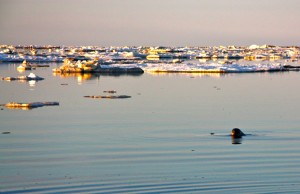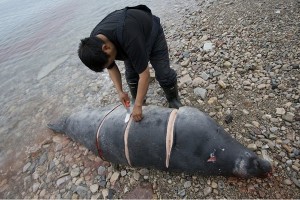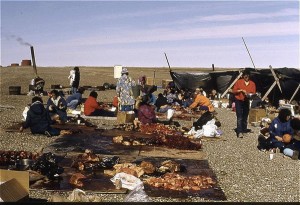Seal Hunting with Yupik Natives
- Details
 A seal swims in the icy waters
A seal swims in the icy watersI am sitting in the little Bering Air offices in a back corner of the already tiny Nome airport. It’s dank, dark, grey, and cold outside. 8:30 am and the sun won’t poke its head above the horizon for another hour or so. I am waiting to catch my flight from Nome to St. Michael via Unalakleet. I am flying through some daylight hours so I will be able to see part of this corner of Alaska from the air. The flight to Nome from Anchorage was dark with nothing to see. It took what seemed forever just to get through security in Anchorage. The highlight of the airport was flirting with a tall, sexy Russian girl who was working at the Starbucks. However, now that I am here, in Nome, I am in full swing adventure mode, preparing to live in the Yupik Eskimo village of St. Michael for the next several months of my life, training sled dogs and running dog-sledding trips into the Northwestern Arctic of Alaska and into the Russian Kamchadal region. Sitting here in the Nome airport, surrounded by the goings-on, I realize that I am minority out here, and that this will be the first time I have ever lived as such. There are not many Viking looking white-boys out here. This is Yupik country, and I am the outsider. At 6-feet 1-inches, and blonde, I “stand out” in the crowd, double entendre intended. Flying out of Nome and into St. Michael is a white-knuckle affair, and one that leaves a lasting impression of the isolation and austere vastness of the arctic. White, wind-whipped seas, and low rolling volcanic cones covered in arctic tundra are the only things you see as the plane makes its way across the lonely part of the world. After landing, my new boss takes me directly to a fuel tank farm where he immediately gets me to work, pumping out mud and water from around the tank perimeters. The first look at the village brings one word to mind, squalor. There is no doubt that while this is technically part of the United States, the village and area is essentially a third world country.
 Hunting on the ice
Hunting on the iceVillage life is filled with mud, garbage, human waste and more mud. It is generous to call the village ugly, yet the region surrounding it is somehow mystical. There is an intangible quality that hangs over the land, making it seem almost prehistoric. The only other place in the world I have experienced anything similar is in the remote regions of Iceland, another tundra covered northern land. There is no doubt that this is frontier living. Even in the 21st century, being here strikes a feeling of being on the edge. One Yupik elder describes this land by saying “it is not the end of the world, but you can see it from here.” Regarding the human interactions, this is the frontier as well, as disagreements are more often solved with fists or bullets than mediation. Beyond the thought that a mere disagreement may be met with fists, the biggest obstacle here as best I can figure is mud. Nasty, gross, filthy, dog-shit filled mud. It is everywhere and it is a part of life here before the snow and ice arrives. No outdoor gear purchased from fancy gear stores survives this stuff. This is the land where Carhartt, and industrial work clothes are essential. Wear a fancy-boy piece of Patagonia and it gets shredded in days. This is especially noticed when working the dog lot. This is my second day in, and I have started working the dogs and dog yard. The dogs get fed a mix of seal fat, high protein kibble and water twice a day. To get the seal fat, raw flippers and blubber get placed into a large outdoor double-boiler where it gets rendered down into a liquid tallow that gets poured over the kibble. Consider this high-octane fuel for the dogs as the calorie return on it is incredible. In addition to the seal fat, Tom Cod also get boiled down, into a soupy fish-broth given to the dogs. Don’t think that the seal and cod magically appear either; Glen, a Yupik, routinely goes out on seal hunts, and the cod is retrieved from nets dropped into the frigid Norton Sound. About every third day, I make a run out to the nets to pull up the fish, place them into large plastic tubs, then bring them back for boiling and rendering.
 A caught seal is butchered
A caught seal is butcheredIf this all sounds grimy and gross, I can tell you, it is. However, I am fortunate because my house is one of the only houses in the village that has its own shower. I am very lucky that after a day spent scooping dog waste, boiling seal fat and handling dogs I get to come home and take a hot shower. Most of the Yupik are not so lucky, as indoor plumbing is a rarity in these parts. For toilet needs, this is the land of the “honeypot”. Outhouses have holding pots called “honeypots” that are used for waste. As they fill up, you carry them out to the side of the muddy streets where they are collected by a weekly “poop-patrol” and they are then brought out to be dumped into a huge lagoon of human waste. Hepatitis runs rampant out here. Before you begin thinking it is all bad, let me tell you that the rewards out here truly help erase the bad. I was invited to go on seal hunts with the Yupik which is an honor and spectacle. As a “Gussiq” – white guy – I am not allowed to hunt the seals, and I don’t want to; but being invited to go out in the boats and observe the hunt, as well as be there on the beach when they return is an experience that is worth the hardship. I was taken out on my first seal hunt with Glen. He told me to “go dress like you’ve never dressed before” and to prepare for the nastiest conditions I could imagine. I put on two layers of long-underwear, an expedition weight top, primaloft pants, Gore-Tex bibs, arctic boots, a down jacket, glacier glasses, a parka mushing-overcoat, fur trapper hat, gloves, hat and seal furred mittens. Barely able to move, I waddled down to the beach where we all loaded into the boat and made our way out into the minus 10 degree weather. Even with all this, I was astonished at how fast my feet and fingers cooled down, and I am a seasoned high-altitude mountaineer. I can honestly say this was one of the most uncomfortable excursions I have participated in. Once out in the boat and floating through the pack ice, I was amazed at how astute, observant and aware the Yupik men are when hunting seal. Glen could spot a spotted seal head from at least a mile away. I have no idea how he pulls this off, but it is truly an amazing thing to see. Glen’s brother in law, Paul, came along and he shot two spotted seals. As we pulled up to the beach of St. Michael, many of the locals turned out for the butchering. The Y’upiq once hunted spotted seals using harpoons and hand-thrown “atlatls” – a combination slingshot and spear. Today, they use .22 caliber rifles to take the seals. Even so, the fact they can spot the seal out in the ice and land a shot is testimony to their skill and heritage of living with what the surroundings give them. When they hit a seal, it naturally floats due to the blubber and fat, making retrieval a matter of keeping an eye on the dead animal and navigating through the pack ice. The retrieval proved to be physical, and rough. Glen directed the boat through pack ice, and “bergie-bits” – loose chunks of ice that can be the size of Volkswagons. This is particularly dangerous, as the saying “the tip of the iceberg” is a reality. What you see on top is about 1/8 of what is below. Disturb it too much and it could roll, and take you with the boat out.
 The haul is divied up by social caste
The haul is divied up by social casteAs Glen brought the boat up to the floating seals, Paul grabbed the gaff – a long metal hook – and handed it to me while he crouched low into the boat and held onto the sides. Paul directed me to thrust the tip of the hook as deep into the seal’s blubber and flesh as possible and then pull it in toward the side of the boat. If this sounds easy, it isn’t. While the seal’s body is covered in a blubber-layer, it is not soft. I had to truly swing the shit out of the gaff to bring it onto the dead seal’s back. Once the hook was set Paul told me to begin pulling it in toward the boat where he and Glen would pull it up and into the bottom. Pulling the seal across the water, and through ice is difficult as the seal weighs close to 300 or 400 lbs. Imagine trying to pull a black bear across an obstacle laden room and you get an idea of what it is to pull a seal through ice-filled water. I could only imagine how this was done when the Yupi’q would hunt the seals out of kayaks and skin boats. Paul and Glen yanked the seal up and into the boat, along with gallons of the briny and ice-cold water. It splashed everywhere and soaked us through our various layers of clothing, adding to the discomfort. Soaked gloves and mittens made the situation seem more dangerous as my fingers began to numb out with a rapidness I have never seen or experienced before. Once the seals were on the boat, Glen brought the boat back to the beaches of the village. I jumped out from the bow, and gripped the ice-covered line and began to pull the boat up with full force, taking advantage of the inertia and making sure to get the boat as far out of the water as possible. The three of us coordinated a lift and toss of the seals onto the beach. Again, our gloves were soaked, and every fiber of me was screaming to get the hell out of the cold and into the warmth of the house. There was still work to be done, and I had to stay with the men to prove my mettle as a measly Gusiq. This was where things really got interesting. Paul and Glen cut the seals up and handed out choice cuts and the ribs to the elders of the village. Everyone got some of the seal, but according to a “pecking order”. The elders got the best cuts while the village n’er do wells got the fat and entrails. It was something, watching this take place, knowing that it has been done this way for hundreds of years prior. This is not like going into a Safeway and buying a steak. After the beach-side butcher house antics, I retired to the house where I tried in vain to thaw out and heat my core and body back to normal levels. Once I recovered I bundled back up and went out to feed the dogs, which takes about an hour of time to prepare, dish out, and clean. The excess blubber from the seals would be used for the dog food and I would be responsible for boiling it down into the creamy tallow that gets added to the kibble. Spending time in the village, you fall into a pattern of work, sleep, and waiting for the weather to cooperate. Finally, snow hit us, and the dogs can get run. The dogs themselves know when the time is prime for sledding. They bark and howl and twitch with giddy anticipation with the thought of harnessing up and hitting the trails. I love each and every one of these dogs, but make no mistake, these dogs are not pets. The reality of dog-mushing is that the dogs are working dogs, born and bred to break trail and pull weight. When they know the time has come to run, they come alive. About Eric Cedric Eric Cedric is a former mountain guide and expedition leader with 20 years of professional experience. Cedric has worked on Denali, Elbrus and a handful of Himalayan peaks. In addition, Cedric is a private pilot and professional environmental and conservation writer. Cedric splits his time each year between the Adirondack Mountains, Southern California and Costa Rica.

